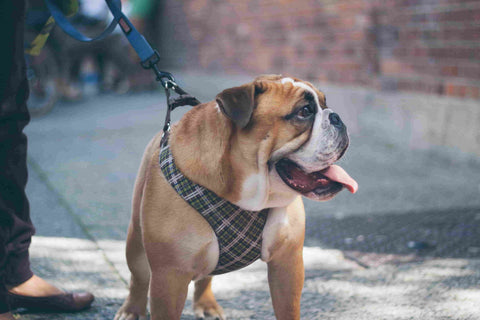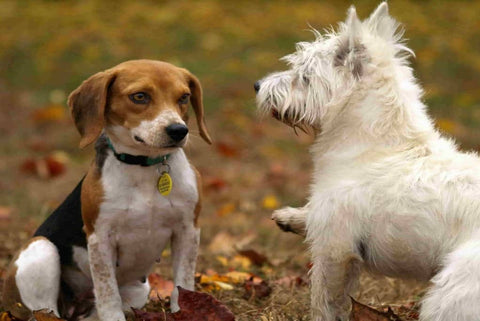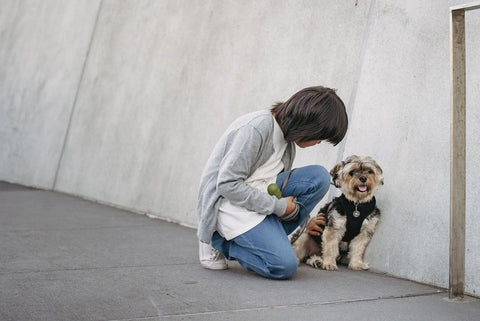What is the Most Comfortable Dog Harness?
When you’re a dog parent, comfort and safety are inevitably two of your biggest priorities. That’s why using a harness instead of a collar is the best choice. A dog harness will reduce the risk of injury, help train your dog, and make your life easier. Harnesses are also a more comfortable way to walk your dog. With all those benefits, you might be wondering why you don’t already have one.
Below, we take you through the steps and considerations to choosing an option that’s just right. Your dog walks will be transformed from a chore to something you enjoy and look forward to every day. When your dog’s happy and comfortable, so are you, so let’s get started!
Factors to Consider in a Comfortable Harness
If your dog isn’t comfortable, it’s going to be a struggle to walk him. It’ll be something he’s resistant to. With that can come a lack of exercise, which affects dogs mentally and physically.
On the other hand, with a comfortable harness, your dog will be excited for your walks which will improve his quality of life. There are three big factors that play a role in how comfortable (or uncomfortable) a dog harness is—material, size, and fit.
Material
Since it’ll be on your dog’s fur and skin, you want a material that’s soft, doesn’t rub and is generally comfortable. At the same, durability is also a key consideration. One of the best options is to choose a dog harness made from nylon, which combines comfort and longevity. Additional padding can also reduce uncomfortable rubbing and make for a better experience.
When the materials have some stretch or a bit of give, it helps your dog move more freely as well. Restricted movement or range of motion can cause injuries along with being generally uncomfortable.
Size
We at Pet&Cuddle have guides that can help you find the right size harness, which is incredibly important. If you get a dog harness that’s too small, it’s going to be tight and restrictive, as well as potentially injuring your dog. If you get one that’s too big, it can get tangled or allow your dog to escape.
Don’t try to guess on the size, and avoid relying on weight alone when you’re buying one. Instead, take your dog’s measurements using a soft tape measure to get the perfect size.
Fit
Even after you take your dog’s measurements, you’ll still want to use the adjustable belts of the harness to get it just right.
A good rule of thumb to check the fit is to put two fingers under any one of the harness straps when your dog is wearing it. It should feel snug, but not so tight that you can’t do this. Also, try to pull the harness over your dog’s head. If it slips off, it needs to be adjusted so that it fits tighter.
Choose the Harness Type For Your Intended Purpose
You may be surprised to know there are actually a few different types of dog harnesses, and they have distinctive features and functions. Below, we delve into the general types of harnesses so you’ll have a better idea of what’s going to work for you.
Back Clip Dog Harness
The primary difference you’ll see when comparing types of harnesses is the clip location. It may seem like a small difference, but it actually has a big impact. A back-clip dog harness is one where there’s a D-ring located at your dog’s back or the top of the harness.
This is where you clip your leash. A back-clip harness can give your dog a bit more freedom to roam, and it’s a good option if your dog doesn’t pull and is well-trained.
If your dog isn’t trained yet, lunges or pulls, or you just generally want more control when you’re walking, a back-clip might not be right for your needs.
Step-In Dog Harness
A step-in harness is a simple, easy-to-use option. The harness itself will have two lightweight straps. Those then have a strap in the middle. You lay a step-in dog harness flat, and your dog steps in. You pull the sides up and snap the closure. If your dog tends to cooperate well, this can be a good option.
Front Clip Dog Harness
For a dog who’s still training on how to walk well, or one who’s prone to pulling, think about a front-clip harness. The leash goes onto the D-ring at the front, where your dog’s chest is. If your dog starts to pull when they’re clipped at the front, it’s going to be uncomfortable for them, although not dangerous. The discomfort is minimal, but it teaches your dog to stop his pulling behavior.
A front-clip harness also gives you a high level of control. If you’re walking in a busy area where there’s a lot of pedestrian or car traffic, you might want the peace of mind of the front clip option.
Dual Clip Dog Harness
Ideally, a dual-clip dog harness offers the option to leash your dog at the back or front clip. You can switch between clips depending on your needs at the time.
If you’re leisurely walking in an open area, for example, you can use the back clip. If you’re working on training techniques or you need more control in a crowded place, use the front clip.
Getting the Right Size for a Dog Harness
We can’t overstate how important choosing the right size of dog harness is for both safety and comfort. To measure your dog, follow the steps below:
- Step One: Use a soft measuring tape so that you can wrap it around your dog. If you don’t have one handy, you can also use a piece of string and a ruler or anything you can easily wrap.
- Step Two: Have your dog stand on all fours and with a straight back. You may need someone to help you with this.
- Step Three: Measure your dog’s lower neck, where it connects with his chest. Wrap the tape measure around the widest point of the neck, which is the girth. Don’t measure too high on the neck. This is where a collar is fitted, but not a harness.
- Step Four: To get a measurement of your dog’s chest, find the widest part. This will be typically directly behind his front legs or armpits. Wrap the tape measure around the chest, and it should be snug but not too tight when you do so.
- Step Five: If you want a harness that’s going to cover your dog’s midsection, measure a line from just behind the front legs to right in front of the back legs.
- Step Six: Once you have your measurements, compare them to the Pet&Cuddle size chart. If your dog is between two sizes, go with the larger option.
- Step Seven: After the harness arrives, check the fit by putting it on, fastening it, and sliding two fingers under any of the straps. If you can’t fit two fingers, it’s too tight. If the straps aren’t snug on your fingers, it’s too big or loose. If the harness comes over your dog’s head easily, it’s also too big or needs to be tightened.
What Are the Other Features to Consider for a Dog Harness?
Along with fit and size, there are few other factors to remember when choosing a dog harness.
- Safety: Choose a harness that’s specifically designed for safety. This means that it has a no-choke design. In general, harnesses are significantly safer and carry a much lower risk than a collar.
- Ease-of-use: Look for dog harnesses with a design that you’ll easily be able to attach and adjust. You don’t want your walks to be a chore. Instead, they should be something you look forward to. An adjustable belt-slide buckle is one easy feature to think about.
- Adjustable belts: Along with specifically choosing adjustable belt-slide buckles, look for an option that will let you adjust the harness to your dog’s exact size and shape. With adjustable features, you’ll get a custom fit, but you’ll still have some room to grow.
- Weight: Skip the bulky, heavy harnesses. Get one that’s lightweight so you can take it on the go.
- Reflective details: If you walk in the early morning, evening or night, reflecting straps or details will keep you and your dog safer.
The Importance of Getting a Comfortable Harness for Dogs
Not all harnesses are the same, and some are higher-quality and more comfortable than others. Taking your time to choose the right one is going to be beneficial for your dog’s health, training, and safety. Get started by taking your dog’s measurements, or contact our expert team at Pet&Cuddle and we can help.
We, the Pet&Cuddle dog lovers, are constantly creating new dog harness collections, which are safe, multifunctional, and effective for training, leading, or adapting purposes.
Discover the latest dog harness collection we created exactly for your dog here.
Questions About Dog Harnesses
We’ve learned a lot about how to best help our customers when they’re choosing gear, including harnesses and leashes for their dogs. With that in mind, we put together some of the questions we get most commonly in the process to help you along the way. Below are answers to some of those questions.
Is It Safe to Use Harnesses for a Puppy?
A harness is one of the safest things you can use to walk your dog at any age. Harnesses disperse pressure evenly and reduce the risk of injury.
With that in mind, you should speak to your vet. Some vets recommend waiting until a puppy is around eight months old before using a harness. When you use one for the first time, regardless of how old your puppy is, do it gradually. You want to ease your puppy into using not just the harness but walking in general.
Can a Dog Wear Harnesses All the Time?
There’s no reason for a dog to wear his harness all the time, and it can become uncomfortable. Instead, your dog should learn that when you bring out the harness, it’s time to walk. When you get home take it off again. This helps your dog know what to expect.
Should I Use a Retractable Leash with a Dog Harness?
We’ve heard concerns from people about the safety of using a retractable leash combined with a dog harness. There’s no reason for concern as it’s a safe and convenient option. Retractable leashes give you flexibility when you’re walking. If you need or want more control, for example, in a congested area, you can give the leash line less length. If you’re in a more open area, you can let your dog roam and explore, which teaches independence.
This goes well with a harness, but do remember to use the back clip when possible. If you’re using the front clip and a retractable leash, don’t let the leash line generate any tension. It creates the feeling that your dog is pulling even if he’s not. That can confuse him, especially if he’s still in training.
When Is it Better to Use a Dog Harness?
One of the many advantages that come with using a dog harness is the fact that it’s usable across pretty much every situation. You can use it for regular walks, training, in public and also more open areas. There aren’t really any scenarios where a harness isn’t a great thing to have.
Get Your Best Dog Harness on Pet&Cuddle!
Once you go over the basics and the features to look for, it’s not too hard to choose the perfect dog harness. If you have questions or just want a little help along the way, feel free to reach out to our team of experts. Helping dog parents get the best products is what we have a passion for.
We, at Pet&Cuddle, have processed all the knowledge and practical experiences to create the perfect harness with a unique design. Comfortable and safe, it now can be easily used for many purposes like training, walking, or adapting to a leash.
Discover the latest products for dogs available on our website!




